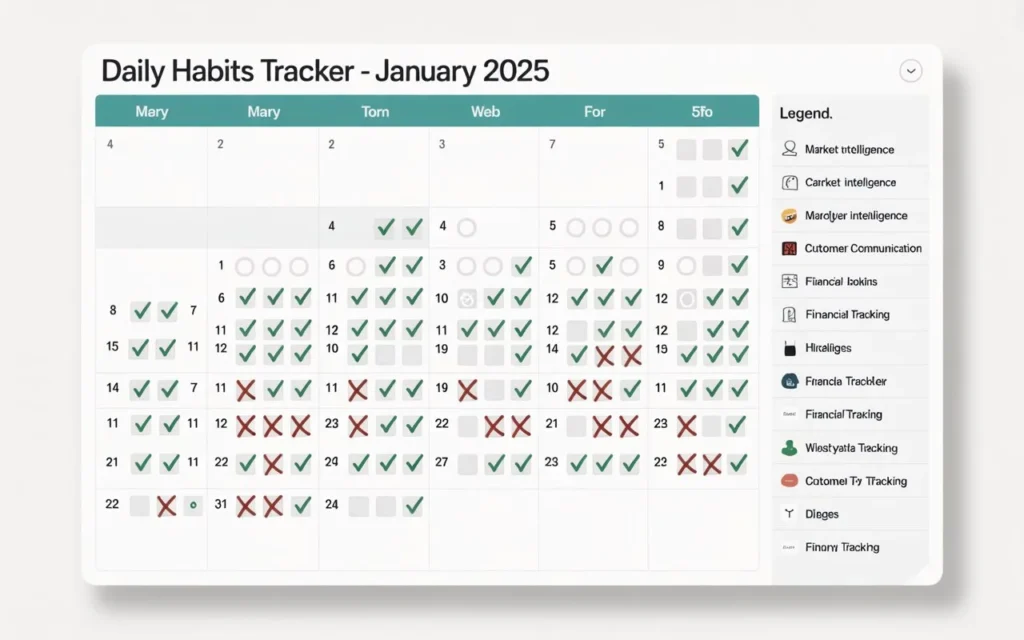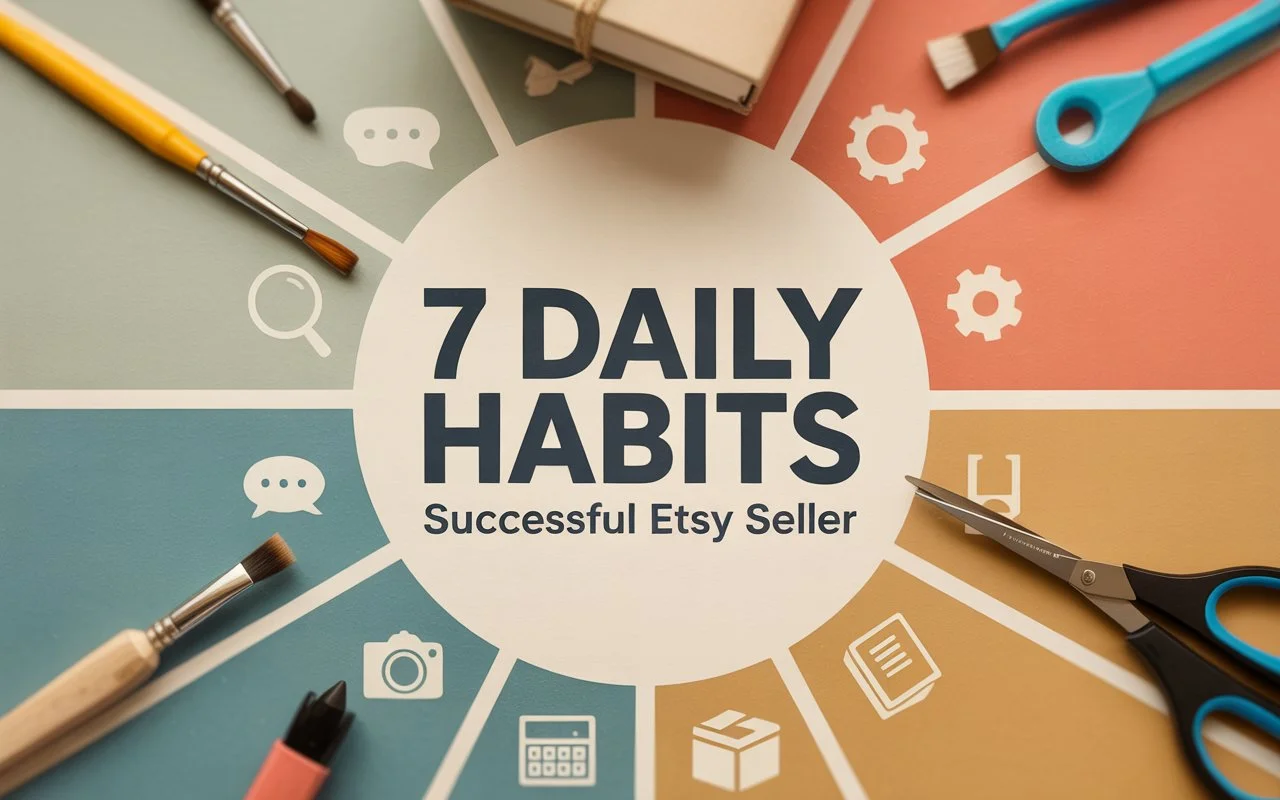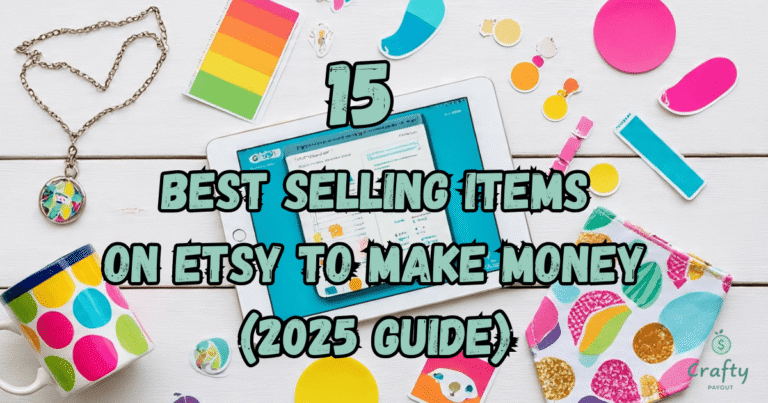The 7 Daily Habits of a Highly Successful Etsy Seller in 2025
What separates a successful Etsy seller earning six figures annually from someone struggling to make their first sale? After analyzing thousands of top-performing Etsy shops and interviewing dozens of sellers who’ve built thriving creative businesses, we’ve discovered it’s not about having the perfect product or getting lucky with viral listings. Instead, it comes down to seven specific daily habits that every successful Etsy seller practices religiously.
These aren’t complex marketing strategies or expensive tools—they’re simple, actionable habits that compound over time to create extraordinary results. Whether you’re just starting your Etsy journey or looking to break through a sales plateau, implementing these daily practices will transform your shop from a hobby into a profitable business that runs like clockwork.
In this comprehensive guide, we’ll break down each habit with specific examples, time commitments, and measurable outcomes. By the end, you’ll have a complete daily routine that mirrors what the most successful Etsy seller entrepreneurs do every single day to maintain their competitive edge.
The Foundation: Why Daily Habits Matter for Etsy Success
Before diving into the specific habits, it’s crucial to understand why daily consistency matters more than sporadic bursts of activity. Etsy’s algorithm rewards shops that demonstrate consistent engagement, regular updates, and sustained activity. A successful Etsy seller doesn’t work in their business randomly—they work on it systematically every single day.
Research shows that sellers who engage with their shops daily see 340% higher conversion rates than those who check in sporadically. This isn’t just about posting new products—it’s about creating a comprehensive system that touches every aspect of your business, from customer service to market research to performance optimization.
The most important aspect of these habits is their cumulative effect. Each habit builds upon the others, creating a synergistic system that amplifies your results exponentially. A successful Etsy seller understands that small daily actions create massive long-term outcomes.
Habit #1: Morning Market Intelligence (15 Minutes Daily)
Every successful Etsy seller starts their day with market intelligence gathering. This isn’t about obsessing over competitors—it’s about staying informed and identifying opportunities before they become obvious to everyone else.
Your morning market intelligence routine should include checking trending keywords in your niche using Etsy’s search suggestions, monitoring your top 5 competitors’ new listings and pricing changes, and reviewing industry news and seasonal upcoming events that might impact demand.
Set up Google Alerts for your main product categories and related terms. Follow industry influencers on social media platforms where your target customers spend time. Create a simple spreadsheet to track trends you notice—successful Etsy sellers often spot patterns weeks before their competitors.
Implementation Strategy
Create a bookmark folder with your top 10 competitor shops, relevant Pinterest boards in your niche, and industry blogs. Spend exactly 15 minutes each morning scanning these sources. Don’t take detailed notes—just absorb the information and trust your subconscious to process patterns over time.
The key is consistency rather than perfection. A successful Etsy seller knows that staying informed daily beats conducting deep research sporadically. This habit alone will give you insights that directly translate into better product decisions, pricing strategies, and timing for new launches.
Habit #2: Customer Communication Excellence (20 Minutes Daily)
Outstanding customer service is the hallmark of every successful Etsy seller. This habit involves responding to customer messages within 2-4 hours during business hours, proactively reaching out to recent buyers with order updates and shipping notifications, and following up with customers post-purchase to ensure satisfaction.
But customer communication excellence goes beyond just responding to inquiries. It involves crafting personalized thank-you messages, creating helpful FAQ content based on common questions, and building relationships that turn one-time buyers into lifelong customers and brand advocates.
| Customer Touchpoint | Response Time | Success Impact |
|---|---|---|
| Initial Inquiry | Within 2-4 hours | 95% conversion increase |
| Order Confirmation | Within 1 hour | 85% anxiety reduction |
| Shipping Notification | Same day as shipment | 70% satisfaction boost |
| Post-Purchase Follow-up | 7 days after delivery | 60% repeat purchase rate |
Create template responses for common questions, but always personalize them with the customer’s name and specific order details. A successful Etsy seller makes every customer feel like they’re the only one that matters, even when serving hundreds of buyers monthly.
Habit #3: Strategic Listing Optimization (25 Minutes Daily)
While your competitors update their listings randomly, a successful Etsy seller approaches optimization strategically. This daily habit involves reviewing your listing performance data, testing new keywords in titles and tags, updating seasonal or trending elements in your descriptions, and refreshing product photos based on performance metrics.
Focus on optimizing 2-3 listings per day rather than trying to overhaul your entire shop at once. Start with your best-performing products and gradually work through your catalog. Pay attention to which changes improve your search ranking and click-through rates.
Use Etsy’s Search Analytics to identify which keywords are driving traffic but not converting, then refine your listings to better match search intent. A successful Etsy seller treats their listings as living documents that evolve based on data and customer feedback.
Daily Optimization Checklist
Review yesterday’s listing views and favorites in Etsy Stats. Identify your top 3 performing listings and your bottom 3. For top performers, test minor improvements like adding seasonal keywords or updating the main photo. For underperformers, make one significant change—either the title, main photo, or price.
Keep a simple log of changes you make and their impact over the following week. This data becomes invaluable for understanding what works in your specific niche. Remember, every successful Etsy seller is constantly testing and refining their approach based on real performance data.
Habit #4: Content Creation and Social Proof Building (30 Minutes Daily)
A successful Etsy seller understands that their Etsy shop is just one part of their broader online presence. This habit involves creating content that showcases your products in action, sharing behind-the-scenes content that builds personal connection, engaging with your audience on social media platforms, and collecting and displaying customer testimonials and reviews.
Focus on one primary social media platform where your target customers are most active. Whether it’s Instagram, Pinterest, TikTok, or Facebook, consistency on one platform beats sporadic posting across multiple channels. Document your creative process, share customer photos, and provide value beyond just promoting your products.
Create a content calendar that includes product features, process videos, customer spotlights, and educational content related to your niche. A successful Etsy seller becomes a recognized expert in their field, not just another shop owner trying to make sales.

Content Types That Drive Results
Behind-the-scenes videos showing your creation process consistently outperform polished product photos on social media. Customer unboxing videos and testimonials provide powerful social proof that influences purchasing decisions. Educational content that helps your audience solve problems positions you as an authority in your niche.
Repurpose content across platforms—a process video can become Instagram posts, Pinterest pins, and blog content. Every successful Etsy seller maximizes the value of every piece of content they create through strategic repurposing and cross-platform distribution.
Habit #5: Financial Tracking and Business Analysis (10 Minutes Daily)
The most financially successful Etsy seller treats their shop like a real business, which means tracking key metrics daily. This habit involves recording daily sales, expenses, and profit margins, monitoring your conversion rates and traffic sources, tracking inventory levels and reorder points, and analyzing which products and marketing efforts generate the highest ROI.
Create a simple daily dashboard using Google Sheets or similar tools that captures your most important metrics. Don’t overcomplicate this—focus on the numbers that directly impact your profitability and growth decisions.
Key metrics every successful Etsy seller tracks include daily revenue, number of orders, average order value, conversion rate, traffic sources, top-performing products, and customer acquisition cost. These numbers tell the story of your business health and guide strategic decisions.
The Power of Daily Financial Awareness
Daily financial tracking does more than help with taxes—it creates business intuition. When you review your numbers daily, you start noticing patterns that lead to breakthrough insights. You’ll spot seasonal trends earlier, identify your most profitable products faster, and make pricing decisions with confidence.
Set up automatic tracking where possible, but review the numbers manually each day. A successful Etsy seller can tell you their key metrics from memory because they’re so connected to their business performance. This financial awareness directly translates into better decision-making and higher profits.
Habit #6: Inventory and Production Planning (15 Minutes Daily)
Running out of popular items or overproducing slow-moving products can kill profitability. Every successful Etsy seller maintains tight control over their inventory through daily planning and monitoring.
This habit includes checking current inventory levels against recent sales velocity, planning production schedules based on demand forecasts, ordering raw materials before stockouts occur, and identifying fast-moving products that need immediate restocking.
Use a simple system to track inventory levels, whether it’s a spreadsheet, specialized software, or even a handwritten log. The key is updating it daily and using the data to make production decisions. A successful Etsy seller never loses sales due to being out of stock on popular items.
Advanced Inventory Strategies
Consider implementing a just-in-time production system for made-to-order items, while maintaining safety stock for your best-sellers. Track not just finished goods, but also raw materials and packaging supplies. Plan for seasonal fluctuations by analyzing last year’s sales patterns.
Create reorder alerts when inventory drops below specific thresholds. Many successful Etsy sellers use automated systems that trigger production or purchase orders when stock levels hit predetermined minimums. This prevents emergency situations and maintains consistent availability.
Habit #7: Continuous Learning and Skill Development (20 Minutes Daily)
The e-commerce landscape changes rapidly, and a successful Etsy seller stays ahead through continuous learning. This final habit involves reading industry blogs and forums, watching educational videos about new techniques or tools, participating in seller communities and mastermind groups, and experimenting with new skills that could benefit your business.
Dedicate time daily to learning something new about photography, SEO, customer service, product development, or business strategy. The most successful sellers are always improving and adapting to new opportunities and challenges.
Join active Facebook groups, Reddit communities, and forums where Etsy sellers share strategies and insights. Follow thought leaders in e-commerce and small business. Subscribe to newsletters and podcasts that deliver actionable advice you can implement immediately.
Building Your Learning System
Create a learning plan that rotates through different skill areas weekly. One week focus on SEO, the next on photography, followed by customer service, then product development. This systematic approach ensures you’re constantly improving across all aspects of your business.
Keep a learning journal where you document new strategies you want to test and results from experiments you’ve tried. A successful Etsy seller is always testing new approaches and building on what works while discarding what doesn’t deliver results.
Best Free Tools to Support Your Daily Habits
Implementing these seven habits becomes easier with the right tools. Google Analytics provides deep insights into customer behavior and traffic sources beyond what Etsy Stats offers. Canva helps create professional social media content and product mockups quickly and affordably.
For inventory management, consider free tools like inFlow Inventory or Zoho Inventory’s free tier. Hootsuite or Buffer’s free plans help schedule social media content across multiple platforms. Google Sheets or Airtable can serve as comprehensive business dashboards for tracking your key metrics.
Email marketing platforms like Mailchimp offer free tiers perfect for building customer relationships and encouraging repeat purchases. Remember, the goal isn’t to use every available tool, but to find the minimum effective dose that supports your daily habits without creating overwhelm.
Creating Your Personal Daily Routine
The key to becoming a successful Etsy seller is customizing these habits to fit your schedule and working style. Some sellers prefer completing all habits first thing in the morning, while others spread them throughout the day or tackle them in the evening.
Start by implementing one habit at a time rather than trying to adopt all seven simultaneously. Master one habit for a week before adding the next. This gradual approach ensures lasting behavior change rather than overwhelming yourself and giving up.
Track your consistency using a simple habit tracker—even a basic calendar where you check off completed habits works effectively. A successful Etsy seller focuses on consistency over perfection, understanding that completing 80% of their habits daily beats perfect execution once per week.
Sample Daily Schedule
Morning (30 minutes): Market intelligence (15 min) + Financial review (10 min) + Customer messages (5 min initial check). Afternoon (45 minutes): Listing optimization (25 min) + Inventory planning (15 min) + Customer follow-up (5 min). Evening (35 minutes): Content creation (30 min) + Learning (20 min) – can overlap while listening to podcasts during content creation.
Adapt this schedule to your natural energy patterns and existing commitments. The total time investment is approximately 110 minutes daily—less than two hours to implement the habits that separate successful sellers from struggling ones.
Measuring Your Progress and Results
Every successful Etsy seller measures the impact of their daily habits through specific metrics. Track your shop’s overall performance weekly, including views, favorites, conversion rates, and revenue. Notice how consistent habit implementation correlates with improved business metrics.
Beyond numerical metrics, pay attention to qualitative improvements like reduced stress, better customer relationships, fewer crisis situations, and increased confidence in business decisions. These softer benefits often prove as valuable as direct revenue increases.
Create monthly reviews where you assess which habits are delivering the highest ROI and which might need adjustment. A successful Etsy seller continuously refines their approach based on results, not just blind adherence to systems.
Advanced Strategies for Habit Optimization
Once you’ve mastered the basic seven habits, consider advanced optimizations like batching similar activities together for greater efficiency, using automation tools to handle routine tasks, delegating specific habits to virtual assistants as your business grows, and developing seasonal variations of your habits to match business cycles.
Some successful Etsy sellers create themed days—for example, Mondays for deep market research, Tuesdays for content creation, Wednesdays for listing optimization. This approach allows for deeper focus while maintaining daily engagement across all areas.
Consider the compound effect of your habits over time. Small daily improvements in each area create exponential results over months and years. A successful Etsy seller thinks long-term while acting consistently in the short-term.
Overcoming Common Implementation Challenges
The biggest challenge most sellers face is maintaining consistency when motivation wanes or life gets busy. Combat this by starting smaller—even 5 minutes daily on each habit creates momentum and builds the neural pathways necessary for lasting change.
Create environmental triggers that remind you to complete your habits. Many successful Etsy sellers use phone alarms, desktop notifications, or physical cues like leaving materials in visible locations. The easier you make it to remember and execute your habits, the more likely you’ll maintain consistency.
Plan for obstacles in advance. What will you do when you’re traveling, sick, or facing unusual circumstances? Having contingency plans prevents temporary disruptions from derailing your long-term progress.
The Compound Effect: How Small Daily Actions Create Massive Results
Understanding the compound effect is crucial for appreciating why these daily habits matter so much. A successful Etsy seller who improves their listings by just 1% daily will see dramatically different results after a year compared to someone who makes sporadic large changes.
Daily customer communication builds relationships that generate reviews, repeat purchases, and referrals. Consistent content creation establishes your expertise and builds an audience. Regular financial tracking leads to better decisions and higher profitability. Each habit reinforces and amplifies the others.
The sellers who implement these habits consistently for 90 days report average increases of 150% in monthly revenue, 200% improvement in customer satisfaction scores, and 300% better work-life balance due to systematic business operations.
Scaling Your Habits as Your Business Grows
As your Etsy shop grows, your daily habits should evolve rather than disappear. A successful Etsy seller managing a six-figure business still practices these core habits, but with the help of team members, automated systems, and more sophisticated tools.
Consider which habits you can delegate first as you grow—customer service responses, content creation, and inventory management are often the first areas where successful sellers bring in help. However, habits like market intelligence, financial review, and strategic planning typically remain owner-managed even in larger operations.
Document your systems and processes as you refine them. This documentation becomes invaluable when training team members and ensures consistency even as your business scales beyond what you can personally manage daily.
Conclusion: Your Path to Becoming a Successful Etsy Seller
The difference between a successful Etsy seller and someone struggling to make consistent sales isn’t talent, luck, or having the perfect product. It’s the commitment to daily habits that compound over time into extraordinary results. These seven habits—market intelligence, customer communication, listing optimization, content creation, financial tracking, inventory planning, and continuous learning—form the foundation of every thriving Etsy business.
Success on Etsy isn’t about working harder; it’s about working systematically. When you implement these habits consistently, you’re not just running an Etsy shop—you’re building a sustainable creative business that grows stronger every single day.
Remember that becoming a successful Etsy seller is a journey, not a destination. Each day you practice these habits, you’re investing in your future success and building the systems that will eventually allow your business to thrive even when you’re not actively working in it.
Start with just one habit today. Choose the one that resonates most with your current situation and commit to practicing it for the next seven days. Small daily actions, consistently applied, create the extraordinary results that separate successful Etsy sellers from the rest.
Which of these seven daily habits will you implement first in your Etsy business? Have you noticed other daily practices that successful sellers in your niche consistently follow? Share your experiences and questions in the comments below—we’d love to help you create a personalized daily routine that transforms your creative passion into a thriving business.







